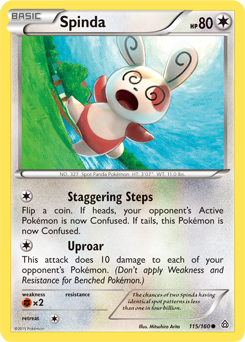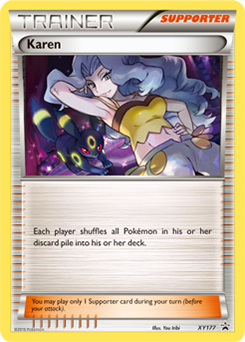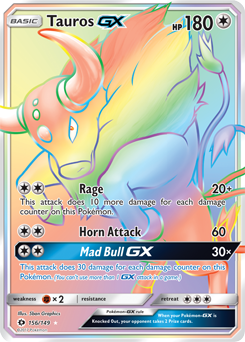Hollow Hunting Through the Junk — Four Powerful Decks Featuring Pokemon-GX
What’s up ‘Beach goers! Welcome, welcome. As of last week we are officially halfway through the Play! Pokemon season and I hope all of your seasons are going well. Though I have not been able to attend as many tournaments as my peers, I am still halfway to a Worlds invitation with 250 / 500 Championship Points. I have only attended two Regional Championships thus far, but, as I suspect is the case with many of you, the back half of my season is ripe with opportunities to earn CP. The awesome thing about this new tournament structure is that, even if you are not on track to earn an invite, each Regionals is a sweet opportunity to earn some money! During the last few weeks I have been busy racking up CP with League Cups, and I would like to share those experiences with you. In today’s article I will review some tips for League Cups before discussing key players from the new Sun and Moon expansion. Thanks for stopping by and I hope you enjoy the read!
League Cups
League Cups are finally here! I was able to attend four League Cups in January, winning one and placing third at another, gathering the two finishes I needed towards my Worlds Invitation. I have learned a lot from my initial experiences at League Cups, and I hope that sharing my own experiences here will help you succeed down the road.
Scouting

It’s no secret that people attempt to scout other players’ deck choices at events, especially smaller level tournaments. Scouting has always been a part of the game, but I have noticed the practice becoming more intense at League Cups lately. League Cups are small tournaments, generally averaging between 20 and 40 Masters players, but they are worth a good amount of Championship Points. Players have the opportunity to earn three fifths of their invite this year at Cups alone, making them relatively contentious events. Scouting a handful of other players decks, especially players that you consider to be top tier, could undoubtedly give you a leg up on the competition. Unfortunately, the reverse is also true. Players that are able to scout your deck before making their selection could have an advantage over you!
I never really used to worry too much about scouting until the issue landed in my lap recently. At the Cup that I was able to win, my round one opponent actually told me that he had switched his deck choice in an attempt to counter my deck completely! I realized after that moment that I would have to be more careful when sleeving up and filling out my deck list.
At another Cup, my friend, Matt Price, played a practice game against another player with Gyarados before the player meeting. Matt was concerned about his Gyarados matchup, so I slipped him a copy of Spinda in order to counter it. Sure enough, Matt ended up playing the Gyarados player in Top 8 and was able to beat him using the copy of Spinda!
Techs are very effective in the Standard format. Sometimes all it takes is one card to significantly swing a matchup. To avoid getting countered, I suggest filling out a few deck lists before you arrive so that you can submit your choice discreetly. If that is not an option, showing up to a tournament early might allow you some time to fill out your list privately before the majority of players get there.
Personally, I don’t love to scout as I think that it can negatively impact a players’ deck choice. For example, it might not be the correct play to switch decks just because you think you see one person playing a list that happens to counter you. I have definitely pulled out a deck to play some games before a tournament with no intention of actually piloting that deck. Others can do the same! Most of the time I would suggest sticking to your guns and playing the list that you have proven to be the most effective and versatile during the course of your testing. Techs, on the other hand, can be very useful. Changing a card here and there last minute, based on some concrete information, can make or break your League Cup! This is why I suggest keeping your binder packed with some of the formats’ hottest techs.
Binder Full of Techs
I played Vespiquen / Zoroark for three of the four League Cups that I participated in this January. Part of what I love about Vespiquen is that the deck can easily be altered to deal with various matchups. I don’t like to bring all of my cards to a tournament, but I do make sure to bring a few different decks and a binder with tech cards in it so that I can prepare my deck for anticipated threats in a pinch. For example, my binder right now has a copy of Spinda, a Zebstrika line, a Garbodor line, a pair of Faded Town, a Karen, a couple copies of Jirachi, Pokémon Ranger, the new Giratina, Mew-EX, a Marowak line, Archeops, Magearna, Magearna-EX, a Vaporeon line, Jolteon-EX, Mewtwo, Mr. Mime and a few Yveltal, just to name a few things. By carrying these cards with me, I make myself a more potent threat at any local tournament.

If I see a group of people roll in with Gyarados, I can pop the Spinda in my deck. If there are a bunch of Mega decks, maybe I can find room in my list for a couple Faded Town. If the best Volcanion player in my area is present, I might swap my Garbodor line in Vespiquen for that Vaporeon line instead. If there are Vespiquen running rampant at your local Cups, maybe you will consider a copy of Karen. Since League Cups are such small events, every match and every opponent matters. In most circumstances, you cannot afford to take more than one loss during swiss, and if you know that one of the best players in the room is playing a deck that you can prepare for, it might behoove you to change a card to sweeten your odds against them.
Navigating Relationships
The tough thing about teching against players is that sometimes those players happen to be your friends. Anyone who has been playing the game for a while has probably encountered this issue, and I think it’s important to know how to resolve things in a way that is respectful while strengthening your position as a player in the long run.
I have a few local players that I consider to be in my “inner” most circle. These are players that I would invite over to my apartment to test. I have no problems telling these players what my plans are for the day, but the mutual understanding has to be that once we disclose information to each other, we will not be altering our lists to tech against each other. Teamwork and friendships are very important in the Pokemon TCG. Information sharing is a huge boon for players, and many times, the more solidified a players network is, the more potent a competitor they are. It is not worth it to burn bridges at a League Cup because you learned a friend’s deck choice in confidence and decided to alter your list specifically to beat them behind their back. You are much better off working together with a few people that you are close to for the common goal of success at League Cups.
The other issue is when many players stop by to ask you what you are playing. This can be a tough situation. You don’t want to lie, but you don’t want to show your hand either. I usually tell people that I am choosing between a handful of decks and that I have not decided yet. I have to emphasize the importance of boundaries in the Pokemon TCG. You want to have a network, which involves sharing information, but the network has to be carefully considered. Balance is key. You can’t share everything with everyone. When I was a newer player, I did not care who saw what I was playing before tournaments started. No one knew who I was, so who would care what I was about to play! Not to mention, it never mattered since I was usually playing my favorite deck anyways. As my skill as a player and as a competitor have increased, so has my self awareness and caution. That being said, you don’t want to ever come off as pretentious either. No one likes a player that thinks they are better than everyone! This shouldn’t be an issue so long as you remember to be respectful and honest. If a player is grilling you about what the play is and you’d rather not say, just let them know that they will have to wait until round one to find out!
No February Cups
I wanted to touch on one last issue before diving into the bulk of my article. Apparently, Tournament Organizers have been advised not to hold League Cups in the month of February. I have been told that it has something to do with the supplies for tournaments not being organized yet. This is frustrating for a number of reasons, but mostly because it hinders the player’s ability to play the game fluidly and slashes opportunities for players to compete towards their Worlds invitation. I hope that Pokemon gets their tournament structure together soon. Many players that won’t be traveling to Anaheim, like myself, will have to wait a month before they get to compete seriously again. Fortunately, I will be attending ARG Circuit Series events this month to make up for the lack of organized play.
Standard Yveltal / Tauros-GX / Garbodor
Tauros-GX is one of my favorite Pokemon to come out of the new set. Tauros’ biggest assets are his formidable HP and low maintenance attacks. The card is just easy to use. Each of Tauros’ three attacks can be performed with a single Double Colorless Energy, making it so that Tauros can port effortlessly into existing archetypes like Yveltal-EX. Because of Tauros’ splashable nature, he is the easiest way to bring a powerful GX attack to existing decks, and will surely see play in the months to come.
Tauros-GX pairs effortlessly with Yveltal-EX. The deck plays Double Colorless Energy, allowing Tauros to attack quickly and with ease. Additionally, the deck already plays Fighting Fury Belt, Garbodor and Parallel City, all of which boost Tauros’ tankability. Nearly no accommodations need to be made for Tauros. The concept of this deck is simple: tank with huge Basic Pokemon that attack for few Energy while disrupting the opponent’s primary strategies with Parallel City and Garbodor.
Fighting Fury Belt
Fighting Fury Belt makes this deck insane. With Fury Belt, Tauros-GX boasts more HP than most Mega Pokemon and all of the Stage 1 Pokemon-GX. That’s something. Since Tool cards still can’t be removed in Standard, Fury Belt makes Tauros instantly as beefy as some of the biggest Pokemon in the game, which is perfect for pulling off big Rage and Mad Bull GX attacks.
Ninja Boy

Ninja Boy adds an extra dimension to this already proven archetype. With Ninja Boy and Tauros in the deck, Yveltal-EX can potentially threaten a huge OHKO anytime there is damage on board. Previously, it took a lot of Energy for Yveltal to get a big OHKO. At Fort Wayne Regionals I remember attaching multiple DCE and Darkness Energy to Yveltal in order to build up a game winning Evil Ball. Usually, it’s only possible to build up one of these Hail Mary Yveltal-EX per game. With Tauros, however, you can easily threaten two big OHKOs per game. Since Tauros can score big OHKOs for just a DCE using its Mad Bull GX attack, you are free to attach the rest of your Energy to Benched Yveltal-EX that can sweep after Tauros has done his job, or vise versa.
The Healing Problem
Part of the reason why Yveltal-EX has fallen out of favor recently, in my opinion, is that players discovered that healing was a good counter to Yveltal’s grindy 2HKO strategy. M Gardevoir-EX and M Mewtwo-EX started to play multiple copies of Fairy Drop while Greninja BREAK began to play Max Potion in their list. Tauros-GX helps solve Yveltal’s healing problem by offering the deck additional OHKO firepower.
For example, until this point, Yveltal had relied on Y Cyclone and 2HKOs to mow through a field of Greninja, eventually ending the game with one Yveltal-EX that could take a final OHKO or two to finish things off. Max Potion threw a big wrench into that strategy. Fortunately, Tauros takes a lot of heavy lifting off of Yveltal’s shoulders. Now, Tauros can dive in head first, taking out both Froakie and Frogadier with a Fury Belted Horn Attack. Say Tauros takes a Bursting Balloon to the face early. No problem! So long as there are six damage counters on Tauros, he can use Mad Bull GX to take a swift OHKO on any opposing Greninja BREAK. The math works out perfectly. Once Tauros takes a single hit, he can take out any Greninja in play with its GX attack. Once Tauros has accumulated two Moonlight Slashes, it can OHKO a regular Greninja with Rage, and OHKO a BREAK so long as they use Moonlight Slash for 80 damage each time. If you are able to survive three hits, either two Moonlight Slash and a Bursting Balloon or multiple Moonlight Slash reduced by Parallel City, you will be able to Rage OHKO any Greninja BREAK in deck. Tauros puts in work! Tauros can easily take four or five Prizes versus Greninja before he goes down. And since Tauros only takes two Energy to attack, your board position should be built up well by the time he does.
Professor Kukui
I love this card. Professor Kukui is both powerful and balanced, and will surely see play. The Supporter effect of adding 20 damage to a Pokemon’s attacks has already proven to be useful through Kukui’s spiritual cousin, Giovanni's Scheme. However, Kukui is a much better card than Giovanni and fits perfectly into Yveltal / Tauros-GX. Kukui allows Tauros and Yveltal-EX to hit surprise numbers for crucial OHKOs while also drawing two cards. Yveltal is a deck that will often sit on its hand, attach an Energy and attack. Kukui contributes to this strategy nicely, granting the deck an opportunity to draw cards without disrupting the hand. With both Kukui and Ninja Boy in deck, opponents will have an even harder time predicting your Tauros play, adding to the Bull’s utility.
This concludes the public portion of this article.
If you'd like to continue reading, consider purchasing a PokeBeach premium membership! If you're not completely satisfied with your membership, you can request a full refund within 30 days.
Each week we post high-quality content from some of the game's top players. Our article program isn't a corporate operation, advertising front, or for-profit business. We set our prices so that we can pay the game's top players to write the best content for our subscribers. Each article topic is carefully selected, goes through multiple drafts, and is touched up by our editors. We take great pride in our program!

